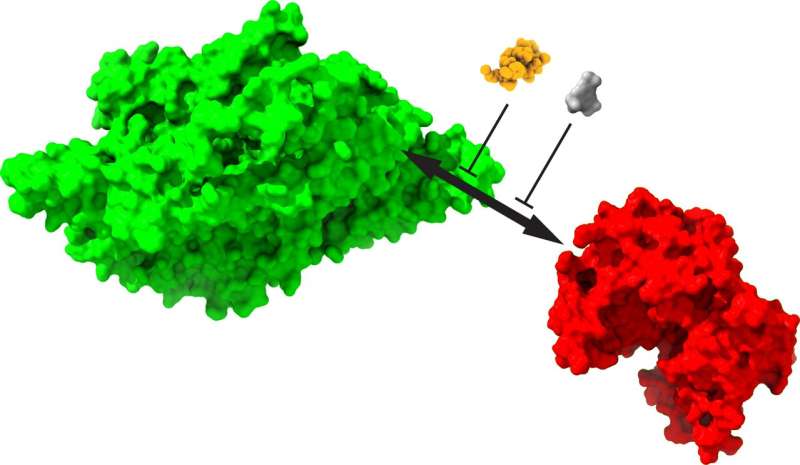
Memories are stored by the interaction of two proteins: a structural protein, KIBRA (green), which acts as a persistent synaptic tag, and a synapse-strengthening enzyme, protein kinase Mzeta (red). Drugs that disrupt memory-perpetuating interaction (other colors) erase long-term and distant pre-established memories. Credit: Changchi Hsieh, Ph.D.
Whether it’s a first visit to a zoo or learning to ride a bike, we carry memories from childhood into adulthood. But what makes these memories last almost a lifetime?
A study in the journal Scientists progress, led by a team of international researchers, has discovered a biological explanation for long-term memories. It revolves around the discovery of the role of a molecule, KIBRA, which serves as “glue” for other molecules, thus solidifying the formation of memory.
“Previous efforts to understand how molecules store long-term memory have focused on the individual actions of single molecules,” says André Fenton, professor of neural sciences at New York University and one of the principal investigators of the study. “Our study shows how they work together to ensure perpetual memory storage.”
“A better understanding of how we retain our memories will help guide efforts to illuminate and treat memory-related afflictions in the future,” adds Todd Sacktor, a professor at SUNY Downstate Health Sciences University and the one of the principal investigators of the study.
It has long been established that neurons store information in memory in the form of strong synapses and weak synapses, which determine the connectivity and function of neural networks. However, molecules at synapses are unstable, continually moving within neurons, wearing out and being replaced within hours or even days, which raises the question: how, then, can memories be stable for periods of time? years, or even decades?
In a study using laboratory mice, scientists focused on the role of KIBRA, or protein expressed by the kidneys and brain, human genetic variants of which are associated with good and poor memory. They focused on KIBRA’s interactions with other molecules essential for memory formation, in this case, Mzeta protein kinase (PKMzeta). This enzyme is the most crucial molecule known to strengthen normal synapses in mammals, but it degrades after a few days.
Their experiments reveal that KIBRA is the “missing link” in long-term memories, serving as a “persistent synaptic beacon,” or glue, that sticks to strong synapses and PKMzeta while avoiding weak synapses.
“During memory formation, the synapses involved in the formation are activated and KIBRA is selectively positioned in these synapses,” says Sacktor, professor of physiology, pharmacology, anesthesiology and neurology at SUNY Downstate. “PKMzeta then attaches to the KIBRA synaptic tag and keeps these synapses strong. This allows the synapses to stick to the newly created KIBRA, attracting more of the newly created PKMzeta.”
More specifically, their experiences in the Scientists progress An article shows that the breaking of the KIBRA-PKMzeta link erases the old memory.
Previous work had shown that randomly increasing PKMzeta in the brain improves weak or faded memories, which was puzzling because it should have done the opposite by acting at random locations, but persistent synaptic labeling by KIBRA explains why the extra PKMzeta improves memory, acting only at KIBRA-labeled sites.
“The mechanism of persistent synaptic marking explains for the first time these findings that are clinically relevant to neurological and psychiatric memory disorders,” observes Fenton, who is also on the faculty of the Neuroscience Institute at NYU Langone Medical Center .
The article’s authors note that the research confirms a concept introduced in 1984 by Francis Crick. Sacktor and Fenton point out that the hypothesis they propose to explain the role of the brain in storing memory despite constant cellular and molecular changes is a mechanism of the Ship of Theseus, borrowed from a philosophical argument from Greek mythology in which new planks replace the old ones to hold Theseus’ ship for years.
“The persistent synaptic marking mechanism we discovered is analogous to how new boards replace old boards to maintain Theseus’s ship for generations, and allows memories to last for years even if the proteins that maintain memory are replaced,” says Sacktor.
“Francis Crick intuited the mechanism of the Ship of Theseus, even predicting the role of a protein kinase. But it took 40 years to discover that the components are KIBRA and PKMzeta and to understand the mechanism of their interaction.”
The study also included researchers from McGill University in Canada, University Hospital Münster in Germany and the University of Texas Medical School in Houston.
More information:
Panayiotis Tsokas et al, KIBRA anchoring the action of PKMζ maintains memory persistence, Scientists progress (2024). DOI: 10.1126/sciadv.adl0030. www.science.org/doi/10.1126/sciadv.adl0030
Provided by New York University
Quote: Research uncovers ‘molecular glue’ that helps ensure memory formation and stabilization (June 26, 2024) retrieved June 27, 2024 from https://medicalxpress.com/news/2024-06-uncovers-molecular-memory-formation-stabilization.html
This document is subject to copyright. Except for fair use for private study or research purposes, no part may be reproduced without written permission. The content is provided for informational purposes only.